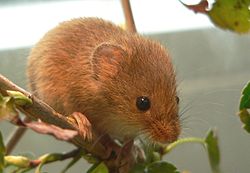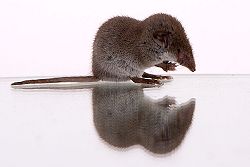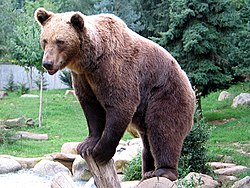List of mammals of Switzerland Last updated October 03, 2025 IUCN Red List status of the mammal species occurring in Switzerland . Nine of them are near threatened , and most are least concern . The following tags are used to highlight each species' status as assessed on the respective Red List published by the International Union for Conservation of Nature :
EX Extinct No reasonable doubt that the last individual has died. EW Extinct in the wild Known only to survive in captivity or as a naturalized populations well outside its previous range. CR Critically endangered The species is in imminent risk of extinction in the wild. EN Endangered The species is facing an extremely high risk of extinction in the wild. VU Vulnerable The species is facing a high risk of extinction in the wild. NT Near threatened The species does not meet any of the criteria that would categorise it as risking extinction but it is likely to do so in the future. LC Least concern There are no current identifiable risks to the species. DD Data deficient There is inadequate information to make an assessment of the risks to this species.
Mountain hare The lagomorphs comprise two families, Leporidae (hares and rabbits ), and Ochotonidae (pikas ). Though they can resemble rodents , and were classified as a superfamily in that order until the early 20th century, they have since been considered a separate order. They differ from rodents in a number of physical characteristics, such as having four incisors in the upper jaw rather than two.
Artiodactyla (even-toed ungulates) Red deer The even-toed ungulates are ungulates whose weight is borne about equally by the third and fourth toes, rather than mostly or entirely by the third as in perissodactyls . There are about 220 artiodactyl species, including many that are of great economic importance to humans.
References ↑ Batbold, J.; Batsaikhan, N.; Shar, S.; Hutterer, R.; Kryštufek, B.; Yigit, N.; Mitsain, G. & Palomo, L. (2016). "Castor fiber " . IUCN Red List of Threatened Species . 2016 e.T4007A115067136. ↑ Amori, G.; Hutterer, R.; Kryštufek, B.; Yigit, N.; Mitsain, G. & Muñoz, L. J. P. (2010). "Sciurus vulgaris " . IUCN Red List of Threatened Species . 2010 e.T20025A9136220. ↑ Bertolino, S.; Amori, G.; Henttonen, H.; Zagorodnyuk, I.; Zima, J.; Juškaitis, R.; Meinig, H. & Kryštufek, B. (2008). "Eliomys quercinus " . IUCN Red List of Threatened Species . 2008 e.T7618A12835766. ↑ Batsaikhan, N.; Henttonen, H.; Meinig, H.; Shenbrot, G.; Bukhnikashvili, A.; Hutterer, R.; Kryštufek, B.; Yigit, N.; Mitsain, G. & Palomo, L. (2016). "Arvicola amphibius " . IUCN Red List of Threatened Species . 2016 e.T2149A115060819. ↑ Banaszek, A.; Bogomolov, P.; Feoktistova, N.; La Haye, M.; Monecke, S.; Reiners, T. E.; Rusin, M.; Surov, A.; Weinhold, U.; Ziomek, J. (2020). "Cricetus cricetus " . IUCN Red List of Threatened Species . 2020 e.T5529A111875852. doi : 10.2305/IUCN.UK.2020-2.RLTS.T5529A111875852.en . Retrieved 19 November 2021 . ↑ Hacklande, K. & Schai-Braun, S. (2019). "Lepus europaeus " . IUCN Red List of Threatened Species . 2019 e.T41280A45187424. ↑ Smith, A.T. & Johnston, C.H. (2019). "Lepus timidus " . IUCN Red List of Threatened Species . 2019 e.T11791A45177198. ↑ Villafuerte, R. & Delibes-Mateos, M. (2019). "Oryctolagus cuniculus " . IUCN Red List of Threatened Species . 2019 e.T41291A45189779. ↑ Amori, G. (2016). "Erinaceus europaeus " . IUCN Red List of Threatened Species . 2016 e.T29650A2791303. ↑ Hutterer, R.; Amori, G.; Krystufek, B.; Yigit, N.; Mitsain, G. & Palomo, L.J. (2010). "Crocidura suaveolens " . IUCN Red List of Threatened Species . 2010 e.T29656A9511068. ↑ Paunović, M. (2019). "Myotis bechsteinii " . IUCN Red List of Threatened Species . 2019 e.T14123A22053752. ↑ Coroiu, I.; Juste, J. & Paunović, M. (2016). "Myotis myotis " . IUCN Red List of Threatened Species . 2016 e.T14133A22051759. ↑ Juste, J. & Paunović, M. (2016). "Myotis blythii " . IUCN Red List of Threatened Species . 2016 e.T14124A22053297. ↑ Hutson, A. M.; Alcaldé, J. T.; Juste, J.; Karataş, A.; Palmeirim, J. & Paunović, M. (2010). "Nyctalus lasiopterus " . IUCN Red List of Threatened Species . 2010 e.T14918A4471682. ↑ Juste, J. & Paunović, M. (2016). "Nyctalus leisleri " . IUCN Red List of Threatened Species . 2016 e.T14919A22016159. ↑ Csorba, G. & Hutson, A.M. (2016). "Nyctalus noctula " . IUCN Red List of Threatened Species . 2016 e.T14920A22015682. ↑ Hutson, A. M.; Spitzenberger, F.; Juste, J.; Aulagnier, S.; Palmeirim, J.; Karatas, A. & Paunovic, M. (2010). "Pipistrellus nathusii " . IUCN Red List of Threatened Species . 2010 e.T17316A6966886. ↑ Gazaryan, S.; Kruskop, S.V. & Godlevska, L. (2021) [errata version of 2020 assessment]. "Plecotus auritus " . IUCN Red List of Threatened Species . 2020 e.T85535522A195861341. ↑ Gazaryan, S. & Godlevska, L. (2020) [amended version of 2020 assessment]. "Plecotus austriacus " . IUCN Red List of Threatened Species . 2020 e.T85533333A195862345. ↑ Gazaryan, S.; Bücs, S. & Çoraman, E. (2021) [errata version of 2020 assessment]. "Miniopterus schreibersii " . IUCN Red List of Threatened Species . 2020 e.T81633057A19585652. ↑ Gerngross, P.; Ambarli, H.; Angelici, F.M.; Anile, S.; Campbell, R.; Ferreras de Andres, P.; Gil-Sanchez, J.M.; Götz, M.; Jerosch, S.; Mengüllüoglu, D.; Monterosso, P. & Zlatanova, D. (2022). "Felis silvestris " . IUCN Red List of Threatened Species . 2022 e.T181049859A181050999. doi : 10.2305/IUCN.UK.2022-1.RLTS.T181049859A181050999.en . Retrieved 3 August 2022 . ↑ Breitenmoser, U.; Breitenmoser-Würsten, C.; Lanz, T.; von Arx, M.; Antonevich, A.; Bao, W. & Avgan, B. (2015). "Lynx lynx " . IUCN Red List of Threatened Species . 2015 e.T12519A121707666. ↑ Gaubert, P.; Carvalho, F.; Camps, D. & Do Linh San, E. (2015). "Genetta genetta " . IUCN Red List of Threatened Species . 2015 e.T41698A45218636. ↑ Boitani, L.; Phillips, M. & Jhala, Y. (2018). "Canis lupus " . IUCN Red List of Threatened Species . 2018 e.T3746A119623865. ↑ Hoffmann, M.; Sillero-Zubiri, C. (2016). "Vulpes vulpes " . IUCN Red List of Threatened Species . 2016 e.T23062A46190249. ↑ McLellan, B. N.; Proctor, M. F.; Huber, D. & Michel, S. (2017). "Ursus arctos " . IUCN Red List of Threatened Species . 2017 e.T41688A121229971. ↑ Reid, F.; Helgen, K. & Kranz, A. (2016). "Mustela erminea " . IUCN Red List of Threatened Species . 2016 e.T29674A45203335. ↑ Maran, T.; Aulagnier, S.; Libois, R.; Kranz, A.; Abramov, A. & Wozencraft, C. (2010). "Mustela lutreola " . IUCN Red List of Threatened Species . 2010 e.T14018A4381596. ↑ McDonald, R. A.; Abramov, A. V.; Stubbe, M.; Herrero, J.; Maran, T.; Tikhonov, A.; Cavallini, P.; Kranz, A.; Giannatos, G.; Kryštufek, B. & Reid, F. (2019). "Mustela nivalis" . IUCN Red List of Threatened Species . 2019 e.T70207409A147993366. ↑ Skumatov, D.; Abramov, A.V.; Herrero, J.; Kitchener, A.; Maran, T.; Kranz, A.; Sándor, A.; Stubbe, M.; Saveljev, A.; Savour-Soubelet, A.; Guinot-Ghestem, M.; Zuberogoitia, I.; Birks, J.D.S.; Weber, A.; Melisch, R. & Ruette, S. (2016). "Mustela putorius " . IUCN Red List of Threatened Species . 2016 e.T41658A45214384. ↑ Abramov, A.V.; Kranz, A.; Herrero, J.; Krantz, A.; Choudhury, A. & Maran, T. (2016). "Martes foina " . IUCN Red List of Threatened Species . 2016 e.T29672A45202514. ↑ Herrero, J.; Kranz, A.; Skumatov, D.; Abramov, A.V.; Maran, T. & Monakhov, V.G. (2016). "Martes martes " . IUCN Red List of Threatened Species . 2016 e.T12848A45199169. ↑ Kranz, A.; Abramov, A. V.; Herrero, J. & Maran, T. (2016). "Meles meles " . IUCN Red List of Threatened Species . 2016 e.T29673A45203002. ↑ Roos, A.; Loy, A.; de Silva, P.; Hajkova, P.; Zemanová, B. (2015). "Lutra lutra " . IUCN Red List of Threatened Species . 2015 e.T12419A21935287. ↑ Lydekker, Richard, ed. (1904). Library of Natural History ↑ Toïgo, C.; Brambilla, A.; Grignolio, S. & Pedrotti, L. (2020). "Capra ibex " . IUCN Red List of Threatened Species . 2020 e.T42397A161916377. ↑ Aulagnier, S.; Giannatos, G. & Herrero, J. (2008). "Rupicapra rupicapra " . IUCN Red List of Threatened Species . 2008 e.T39255A10179647. ↑ Lovari, S.; Lorenzini, R.; Masseti, M.; Pereladova, O.; Carden, R.F.; Brook, S.M. & Mattioli, S. (2018). "Cervus elaphus " . IUCN Red List of Threatened Species . 2018 e.T55997072A142404453. ↑ Masseti, M.; Mertzanidou, D. (2008). "Dama dama " . IUCN Red List of Threatened Species . 2008 e.T42188A10656554. doi : 10.2305/IUCN.UK.2008.RLTS.T42188A10656554.en . Retrieved 19 November 2021 . ↑ Lovari, S.; Herrero, J.; Masseti, M.; Ambarli, H.; Lorenzini, R. & Giannatos, G. (2016). "Capreolus capreolus " . IUCN Red List of Threatened Species . 2016 e.T42395A22161386. ↑ Keuling, O. & Leus, K. (2019). "Sus scrofa " . IUCN Red List of Threatened Species . 2019 e.T41775A44141833. External links
Sovereign states States with limited Dependencies and
This page is based on this
Wikipedia article Text is available under the
CC BY-SA 4.0 license; additional terms may apply.
Images, videos and audio are available under their respective licenses.















